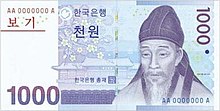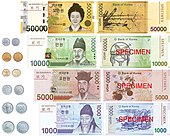South Korean won
| won | |
|---|---|
| Country: |
|
| Subdivision: | 1 won = 100 chon (McCune-Reischauer) / Jeon (revised Romanization) |
| ISO 4217 code : | KRW |
| Abbreviation: | ₩ |
|
Exchange rate : (August 27, 2020) |
1 EUR = 1,400 KRW CHF 1 = KRW 1,302 KRW |
The won (currency symbol ₩ ) is the currency of South Korea . The ISO 4217 code is KRW. A won is divided into 100 Chŏn ( Hangeul 전 , Revised Romanization: Jeon). However, the Ch allerdingsn no longer has any practical significance.
Coins
There are 1, 5, 10, 50, 100 and 500 won coins.
The 1 and 5 won coins are uncommon. The 10 won coin has been made of copper and aluminum since December 2006 and is only 18 mm in size, but it is still possible to pay with the 24 mm 10 won coins from previous years (with the same back as the smaller 10 won coin).
The 1, 5 and 10 won coins were first issued on August 16, 1966.
Bills


There are 1,000, 5,000, 10,000 and 50,000 won notes - the central bank, the Bank of Korea, issues coins and notes . The notes show famous men ( Yi Hwang , Yi I and Sejong ) as well as a famous artist ( Shin Saimdang ) on the new 50,000 won note.
On February 11, 2010, the Bank of Korea announced that the number of 50,000 won notes in circulation at the end of January 2010 was 212,000,000. That is 5.3% of all notes in circulation.
As a comparison value, the proportion of 1,000 won notes was given as around 30%, the proportion of 5,000 won notes with 5% and the proportion of 10,000 won notes with more than 55%.
Word origin
| Korean spelling | |
|---|---|
| Korean alphabet : | 원 |
| Hanja : | 圓 |
| Revised Romanization : | won |
| McCune-Reischauer : | Won |
"Won" is the Korean pronunciation of an East Asian money-counting word that is common to the Chinese, Japanese, and Korean languages and is used for the currencies of China, Japan, and the two Koreans. This measure word was originally with the Chinese characters 圓 written, but in the 20th century in the two Koreas with the Hangul spelling 원 , in Japan in 1946 with the simplified form 円 and in the PRC with the abbreviation 元 rare (also 圆 ) was replaced. As a traditional character, the character can still be found on the notes and coins of the Republic of China ( New Taiwan dollar ).
The pronunciation of the sign is derived from an earlier Chinese pronunciation in all countries, but has evolved separately from one another. Today the number word is on Mandarin yuán , in Japanese en and in Korean won pronounced. However, the character 원 (won) is only used for Korean currencies in Korea today. To approximate the modern Chinese and Japanese pronunciation, the unit of renminbi 위안 (wian) and yen 엔 (en) is written .
Both the amount (e.g. 500 / obaek ) and the counting word (won) are expressed in Sino- Korean today in South Korea .
history
The won was pegged to the US dollar after World War II. On December 6, 1947, North Korea established its own central bank and currency. From February 15, 1953 to June 9, 1962, the Hwan was in force in the areas controlled by South Korea.
On January 2, 2006, a new 5,000 won banknote was issued. The old 5,000 won banknote was often confused with the 1,000 won banknote of the time; therefore the new banknote was a different size. Since February 2006, the 1,000 won and 10,000 won banknotes were no longer issued, but instead relied on the existing supply. As of January 22, 2007, these banknotes were also replaced by new, forgery-proof banknotes.
On June 23, 2009, the 50,000 won note was issued as the new highest banknote.
See also
Web links
Individual evidence
- ^ KBS World : 50,000-won Bills Continue to Penetrate Market , February 11, 2010
- ↑ The Korea Times : W50,000 Bills Shift Transaction Culture , 23. June 2009



